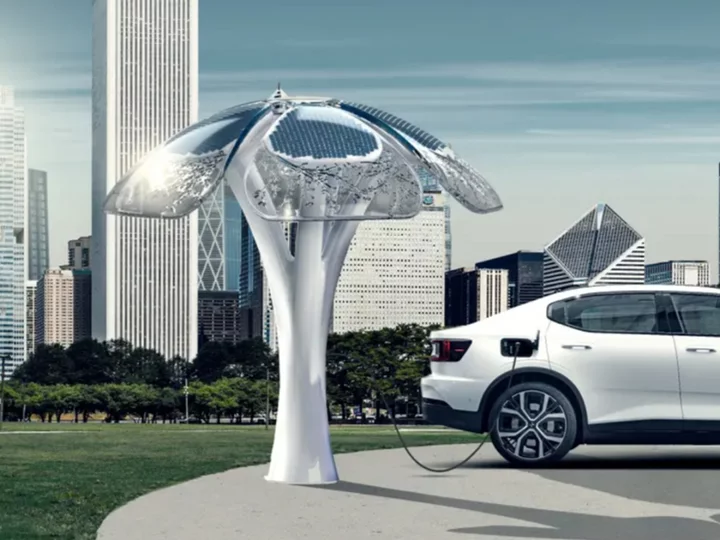A UK startup is close to full-scale commercial production of solar trees that serve as clean energy charging stations for electric cars, according to the company’s chief executive. SolarBotanic Trees, which was founded last year, is developing two different sized versions of the tree, one 5.5 metres tall tree and another 3.5 metres tall, with the first installations planned for early next year in Oxford. “The idea is to put solar panels on a domed surface like the canopy of a tree, and then place a battery storage system into the trunk,” Chris Shelley, CEO of SolarBotanic, told The Independent. “Putting solar cells and batteries into the same structure is very practical, as it allows them to store excess energy without having to solely rely on its backup grid supply.” The number of electric vehicle (EV) charging stations in the UK has risen by more than a third over the last year in an effort to keep up with growing demand. There are now more than 25,000 locations as of May 2023, according to EV mapping service Zapmap, though this is still well short of the 325,000 charging points that the UK’s Climate Change Committee claims will be necessary by 2032. SolarBotanic already has deals in place with EV infrastructure suppliers to build trees for several sites in the UK, Mr Shelley said, including an order of 200 trees from the Raw Charging Group. The initial idea was to create a structure capable of harvesting both solar and wind energy, using photovoltaic leaves that flutter in the wind to generate additional power. Preliminary research found that wind harvesting via this method is not sufficiently advanced at present to be commercially viable in the near term, however it remains a prospect fot the future. For now, SolarBotanic’s focus is on entering production later this year in order to deliver the solar trees to UK customers at the start of 2024. From there, the company plans to enter other markets, including Europe and the US, as well as develop customisable structures to suit other applications. These include large trees with integrated seating underneath to be used in town squares or pub gardens, with people able to charge their phones or even warm themselves up from inbuilt infrared heating fixtures. “There are quite alot of variations on the core theme,” Mr Shelley said. “Offgrid versions that don’t need to meet the electricity demands of an electric vehicle could serve as work or social areas in town squares with telephone and laptop charging, seating and shelter. “Beyond commercial and municipal uses, the trees could go in people’s gardens to supplement rooftop solar panel setups, or several of them could even meet the annual electrical requirement of a medium-sized house.” Read More Scientists figure out how to turn rocks into batteries Japan aims to beam solar power from space by 2025 Scientists break world record for solar power window material Electric cars could save more than 100,000 lives, study claims Scientists smash world record for solar power window material Instagram has stopped working properly
A UK startup is close to full-scale commercial production of solar trees that serve as clean energy charging stations for electric cars, according to the company’s chief executive.
SolarBotanic Trees, which was founded last year, is developing two different sized versions of the tree, one 5.5 metres tall tree and another 3.5 metres tall, with the first installations planned for early next year in Oxford.
“The idea is to put solar panels on a domed surface like the canopy of a tree, and then place a battery storage system into the trunk,” Chris Shelley, CEO of SolarBotanic, told The Independent.
“Putting solar cells and batteries into the same structure is very practical, as it allows them to store excess energy without having to solely rely on its backup grid supply.”
The number of electric vehicle (EV) charging stations in the UK has risen by more than a third over the last year in an effort to keep up with growing demand.
There are now more than 25,000 locations as of May 2023, according to EV mapping service Zapmap, though this is still well short of the 325,000 charging points that the UK’s Climate Change Committee claims will be necessary by 2032.
SolarBotanic already has deals in place with EV infrastructure suppliers to build trees for several sites in the UK, Mr Shelley said, including an order of 200 trees from the Raw Charging Group.
The initial idea was to create a structure capable of harvesting both solar and wind energy, using photovoltaic leaves that flutter in the wind to generate additional power.
Preliminary research found that wind harvesting via this method is not sufficiently advanced at present to be commercially viable in the near term, however it remains a prospect fot the future.
For now, SolarBotanic’s focus is on entering production later this year in order to deliver the solar trees to UK customers at the start of 2024.
From there, the company plans to enter other markets, including Europe and the US, as well as develop customisable structures to suit other applications.
These include large trees with integrated seating underneath to be used in town squares or pub gardens, with people able to charge their phones or even warm themselves up from inbuilt infrared heating fixtures.
“There are quite alot of variations on the core theme,” Mr Shelley said. “Offgrid versions that don’t need to meet the electricity demands of an electric vehicle could serve as work or social areas in town squares with telephone and laptop charging, seating and shelter.
“Beyond commercial and municipal uses, the trees could go in people’s gardens to supplement rooftop solar panel setups, or several of them could even meet the annual electrical requirement of a medium-sized house.”
Read More
Scientists figure out how to turn rocks into batteries
Japan aims to beam solar power from space by 2025
Scientists break world record for solar power window material
Electric cars could save more than 100,000 lives, study claims
Scientists smash world record for solar power window material
Instagram has stopped working properly









